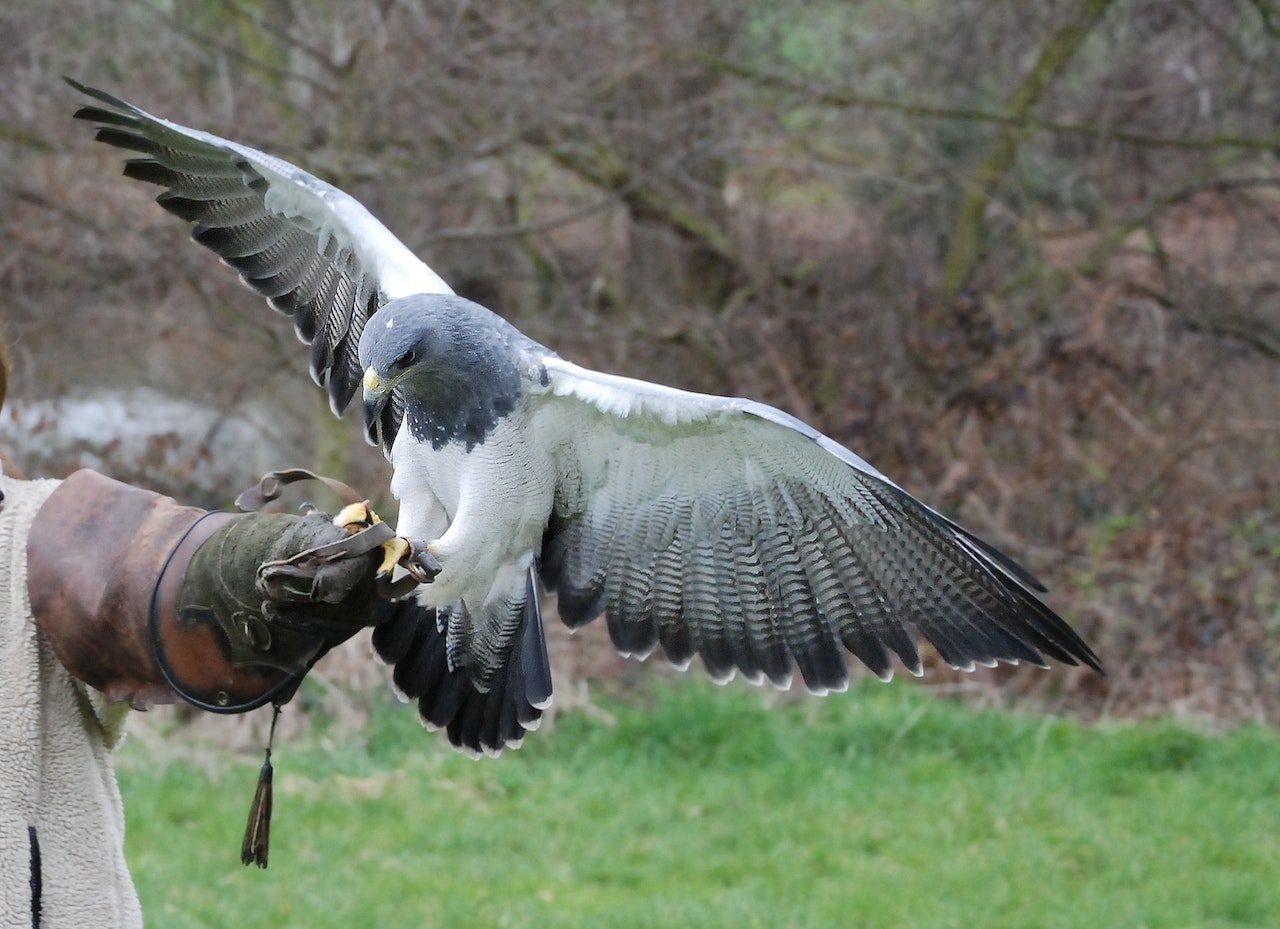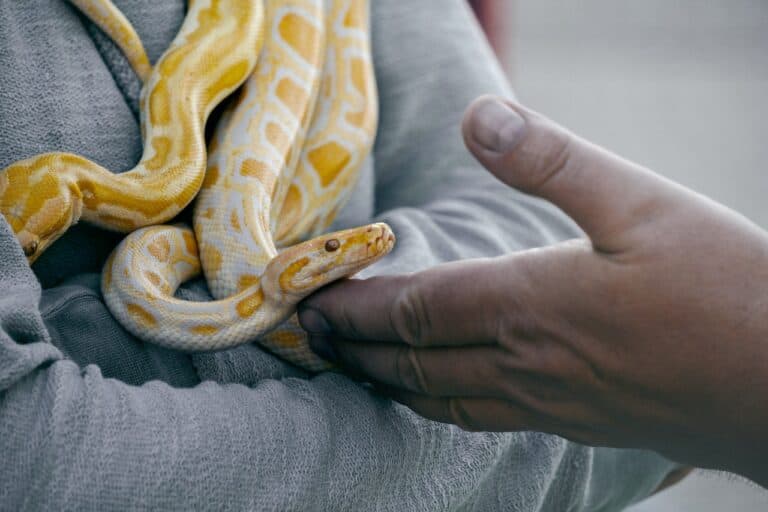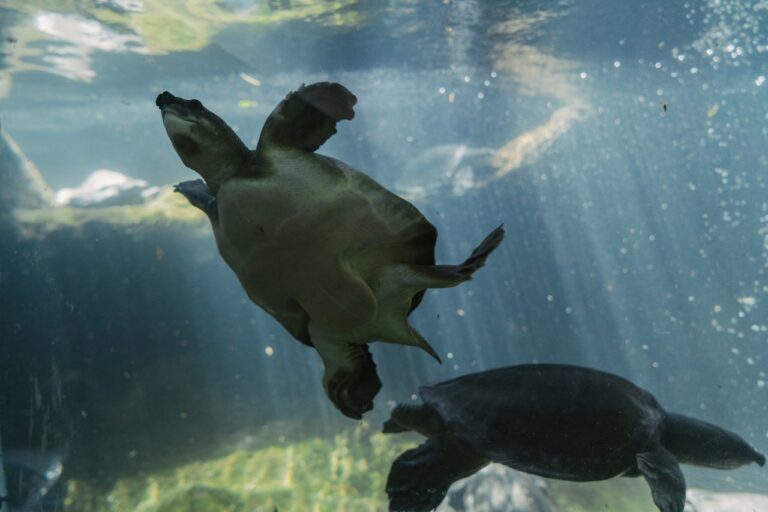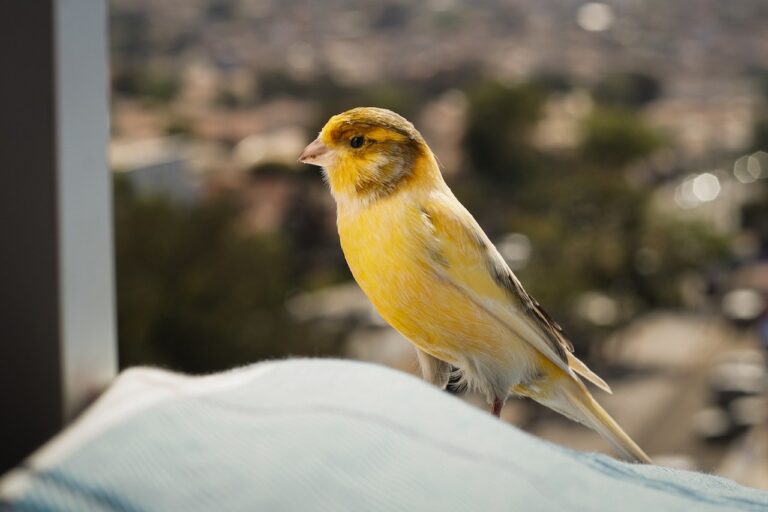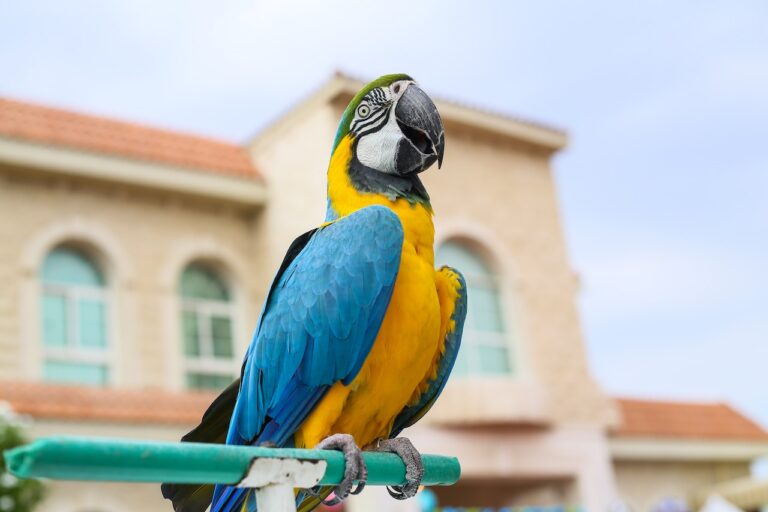Training Techniques for Exotic Birds: A Comprehensive Guide
Exotic birds are fascinating creatures that require specialized care and training.
Whether you are a new bird owner or an experienced trainer, understanding the basics of bird training is essential to building a strong and positive relationship with your feathered friend. From positive reinforcement techniques to advanced training methods, there are many effective ways to train exotic birds.
One of the most important aspects of bird training is building trust and love with your bird.
Positive reinforcement techniques, such as rewarding good behavior with treats and praise, can help establish a strong bond between you and your bird. Consistency in training sessions is also key, as birds thrive on routine and repetition.
Understanding and responding to bird behavior is another critical component of training. By observing your bird’s body language and vocalizations, you can learn to recognize their needs and preferences.
Advanced training techniques, such as teaching birds to talk and performing tricks, can also help stimulate their minds and keep them entertained.
Key Takeaways
- Building trust and love is essential to successful bird training.
- Positive reinforcement techniques and consistency are key to establishing a strong bond with your bird.
- Understanding bird behavior and utilizing advanced training techniques can help keep your bird happy and engaged.
Understanding Exotic Birds
Exotic birds are known for their high intelligence, complex social structures, and exceptional mimicry skills. Some of the most popular exotic birds include parrots, cockatoos, and macaws. These birds require mental stimulation to maintain their mental health and prevent boredom.
Mental stimulation can be provided through various means such as toys, puzzles, and training. Training can be an effective way to provide mental stimulation and improve the bond between the bird and its owner.
Macaws are one of the most intelligent and social species of exotic birds. They require a lot of attention and mental stimulation to prevent boredom and destructive behavior. Providing toys, puzzles, and training sessions can help keep them mentally stimulated and happy.
Intelligence is not the only factor that contributes to the mental health of exotic birds. Social interaction with their owners and other birds is also important. Owners should ensure that their birds have enough social interaction to prevent loneliness and depression.
In summary, exotic birds are intelligent and social creatures that require mental stimulation to maintain their mental health. Providing toys, puzzles, and training sessions can help keep them mentally stimulated and happy. Owners should also ensure that their birds have enough social interaction to prevent loneliness and depression.
Basics of Bird Training
Training a pet bird can be a rewarding experience for both the bird and the owner. However, it requires patience, consistency, and a clear understanding of the training techniques. Here are some basic bird training techniques that every bird owner should know:
1. Positive Reinforcement
Positive reinforcement is one of the most effective training techniques for birds. This involves rewarding the bird for exhibiting the desired behavior. The reward can be in the form of treats, praise, or attention. For example, if the bird steps up on the owner’s hand when commanded, the owner can reward the bird with a treat or praise.
2. Consistency
Consistency is key when it comes to bird training. The owner should use the same commands and rewards every time to avoid confusing the bird. The training sessions should also be consistent in terms of timing and duration.
3. One Behavior at a Time
Teaching one behavior at a time is important to prevent the bird from becoming overwhelmed or confused. The owner should start with basic commands such as “step up” or “come here” and gradually move on to more complex behaviors.
4. Short Training Sessions
Birds have short attention spans and can quickly become bored or frustrated during long training sessions. It is recommended to keep the training sessions short, usually no more than 10-15 minutes at a time.
5. Use Positive Language
Using positive language during training can help reinforce positive behavior. Instead of saying “no” or “stop,” the owner should use positive language such as “good job” or “well done.”
6. Patience
Training a bird takes time and patience. The owner should not expect the bird to learn a behavior overnight. It may take several training sessions before the bird learns a new behavior.
Overall, bird training requires patience, consistency, and positive reinforcement. With these basic techniques, any bird owner can train their bird to exhibit desired behaviors.
Positive Reinforcement Techniques
Positive reinforcement is an effective and humane method for training exotic birds that involves rewarding desired behavior. By using positive reinforcement techniques, the bird learns new behaviors through repetition and positive reinforcement training.
This method is based on the principle that a bird will repeat a behavior that results in a positive consequence.
Treats
One of the most effective ways to train a bird with positive reinforcement is by using treats. Treats should be small and easy to eat, and should be something that the bird enjoys. Examples of treats include seeds, nuts, and fruits. When the bird performs a desired behavior, it should be immediately rewarded with a treat. This will help to reinforce the behavior and encourage the bird to repeat it.
Praise
In addition to treats, praise is also an important component of positive reinforcement training. Birds respond well to positive feedback, and praising a bird for performing a desired behavior can be just as effective as giving it a treat. When praising a bird, it is important to use a positive tone of voice and to make eye contact with the bird.
Desired Behavior
To effectively use positive reinforcement techniques, it is important to identify the desired behavior that you want the bird to learn. Once the desired behavior has been identified, you can begin training the bird by rewarding it for performing that behavior. Over time, the bird will learn to associate the desired behavior with the positive consequence of receiving a reward.
Repetition
Repetition is key when it comes to positive reinforcement training. In order for the bird to learn a new behavior, it needs to be reinforced consistently over a period of time. This means that the behavior should be rewarded every time it is performed, until the bird has learned to associate the behavior with the reward.
Overall, positive reinforcement techniques are a humane and effective way to train exotic birds. By using treats, praise, and consistent reinforcement of desired behavior, you can help your bird to learn new behaviors and strengthen your bond with it.
Negative Reinforcement and Punishment
Negative reinforcement and punishment are two training techniques that are often misunderstood and misused. Negative reinforcement is the removal of an unpleasant stimulus after the bird performs a desired behavior, while punishment is the application of an unpleasant stimulus after the bird performs an undesired behavior.
While negative reinforcement can be an effective training technique, punishment should be used with caution, as it can lead to fear, aggression, and other negative behaviors in birds. Punishment can also damage the relationship between the bird and its owner, as the bird may associate the unpleasant stimulus with the owner rather than its own behavior.
Positive punishment, which involves the application of an unpleasant stimulus after the bird performs an undesired behavior, should be avoided altogether. This type of punishment can cause physical and emotional harm to the bird and is not an effective training technique.
When using negative reinforcement, it is vital to ensure that the bird understands which behavior is being reinforced. This can be achieved by immediately removing the unpleasant stimulus after the desired behavior is performed. Consistency is also key when using negative reinforcement, as inconsistent application can lead to confusion and frustration in the bird.
Overall, while negative reinforcement can be an effective training technique, punishment should be used with caution and positive punishment should be avoided altogether. Consistency and clear communication are key when using negative reinforcement to train exotic birds.
Training Sessions and Consistency
Training exotic birds requires patience, dedication, and consistency. To achieve the desired results, it is important to establish a routine and stick to it. In this section, we will discuss the importance of training sessions and consistency in bird training.
Training Sessions
When it comes to training sessions, it is important to keep them short and focused. Birds have a short attention span, so training sessions should not exceed 10-15 minutes. It is also important to create a distraction-free environment to help the bird stay focused.
During training sessions, it is important to use positive reinforcement techniques to encourage desired behavior. This can include using treats, praise, or a clicker to mark the desired behavior. It is important to remember that birds respond best to positive reinforcement, so avoid using punishment or negative reinforcement techniques.
Consistency
Consistency is key when it comes to training exotic birds. Birds thrive on routine, so it is important to establish a consistent training schedule. This can include training at the same time each day and using the same training techniques.
Consistency also applies to the training environment. It is important to establish a consistent training area that is free of distractions and noise. This will help the bird stay focused and engaged during training sessions.
In addition to establishing a consistent training schedule and environment, it is important to be consistent with training techniques. This means using the same positive reinforcement techniques and commands each time you train your bird. Consistency will help your bird understand what is expected of them and will make training more effective.
Overall, training exotic birds requires patience, dedication, and consistency. By establishing a routine and sticking to it, you can help your bird learn new behaviors and tricks. Remember to keep training sessions short and focused, use positive reinforcement techniques, and be consistent in your training approach.
Building Trust and Love
Building trust and love is an essential part of training exotic birds. Without trust, it is difficult to establish a bond with the bird, and without love, the bird may not be motivated to learn. Here are some tips on how to build trust and love with your exotic bird:
- Spend time with your bird: The more time you spend with your bird, the more comfortable it will become with you. Exotic birds are social creatures and need to spend time with their owners to build a bond. Spend time talking to your bird, playing with it, and giving it treats.
- Be patient: Building trust takes time, and it is essential to be patient with your bird. Do not force your bird to do anything it is not comfortable with. Instead, let your bird take its time and build trust at its own pace.
- Use positive reinforcement: Positive reinforcement is key to building trust and love with your bird. When your bird does something right, reward it with treats, praise, or affection. This will help your bird associate good behavior with positive outcomes.
- Respect your bird’s boundaries: It is important to respect your bird’s boundaries and not force it to do anything it does not want to do. If your bird is not comfortable with something, give it space and try again later.
- Be consistent: Consistency is essential when building trust and love with your bird. Stick to a routine and be consistent with your training. This will help your bird feel more comfortable and confident around you.
By following these tips, you can build trust and love with your exotic bird and establish a strong bond. Remember to be patient, use positive reinforcement, and respect your bird’s boundaries. With time and effort, you can create a loving and trusting relationship with your bird.
Understanding and Responding to Bird Behavior
Exotic birds have unique behaviors that can be challenging to understand and respond to. It is important to recognize that birds communicate through body language, vocalizations, and behavior. By understanding bird behavior, you can respond appropriately and build a stronger bond with your feathered friend.
Behavior
Birds have a natural instinct to fly, forage, and socialize. When kept in captivity, they may exhibit behaviors that are not natural for them, such as feather plucking, screaming, or biting. It is important to recognize these behaviors and address the underlying cause. For example, feather plucking may be a sign of boredom or stress, while screaming may indicate a need for attention or lack of stimulation.
Fear
Birds can become fearful of certain people or objects. Fearful behavior may include flapping wings, cowering, or biting. It is important to respond to fearful behavior in a calm and reassuring manner. Avoid forcing the bird to interact with the object or person causing fear. Instead, gradually introduce the bird to the object or person in a positive and non-threatening way.
Body Language
Birds communicate through body language, which can include fluffing feathers, tail wagging, and head bobbing. It is important to observe your bird’s body language to understand their mood and needs. For example, a bird with fluffed feathers may be cold or sick, while a bird with a wagging tail may be excited or happy.
Bites
Birds may bite for a variety of reasons, such as fear, aggression, or territorial behavior. It is important to respond to bites in a calm and neutral manner. Avoid punishing the bird for biting, as this can reinforce the behavior. Instead, identify the underlying cause of the bite and address it accordingly.
Handling
Proper handling is important for building trust and a strong bond with your bird. It is important to handle your bird gently and with respect. Avoid grabbing the bird or restraining them forcibly. Instead, use positive reinforcement techniques to encourage the bird to step up onto your hand or perch.
Behavior Consultant
If you are struggling to understand or respond to your bird’s behavior, consider seeking the help of a behavior consultant. A behavior consultant can help you identify the underlying cause of your bird’s behavior and develop a plan to address it. With patience and understanding, you can build a strong and rewarding relationship with your exotic bird.
Advanced Training Techniques
Once your exotic bird has mastered the basics of positive reinforcement training, you may want to consider incorporating some advanced techniques to further enhance their skills. Here are some advanced training techniques that you can use to take your bird’s training to the next level:
Shaping
Shaping is a technique that involves breaking down a complex behavior into smaller, more manageable steps. By reinforcing each step along the way, you can gradually shape the behavior you want your bird to perform. This technique requires patience and persistence, but it can be a powerful way to train your bird to perform complex behaviors.
Capturing
Capturing is a technique that involves waiting for your bird to perform a behavior on their own, and then reinforcing that behavior. This technique can be useful for capturing natural behaviors that your bird already performs, such as singing or playing with a toy. By reinforcing these behaviors, you can encourage your bird to perform them more often.
Targeting
Targeting is a technique that involves teaching your bird to touch a target, such as a stick or a target ball. This technique can be useful for teaching your bird to move in a specific direction, or to perform behaviors at a distance. By gradually moving the target, you can teach your bird to follow it and perform the desired behavior.
Clicker Training
Clicker training is a technique that involves using a clicker to mark the exact moment that your bird performs the desired behavior. By pairing the click with a treat, you can quickly and effectively reinforce the behavior you want your bird to perform. Clicker training can be a powerful way to train your bird to perform complex behaviors, and it can be particularly useful for shaping and capturing behaviors.
By using these advanced training techniques, you can take your bird’s training to the next level and teach them to perform complex behaviors. However, it’s important to remember that these techniques require patience, persistence, and consistency. With time and practice, you can help your bird develop their skills and become a confident and well-trained companion.
Teaching Birds to Talk
Teaching a bird to talk can be a fun and rewarding experience for both the bird and its owner. However, it’s important to note that not all bird species can talk, and even those that have the ability sometimes choose not to use it. Before attempting to teach your bird to talk, it’s important to bond with your feathered friend and form reasonable expectations of it.
Learning About Your Bird
The first step in teaching your bird to talk is to learn about your bird’s species. Not all birds can or will talk, so it’s important to find out more about your bird. There isn’t much point trying to teach a bird to talk if it’s just going to whistle back at you. Some of the bird species that can learn to speak include:
- Budgerigars
- Monk Parakeets
- Amazonian Parrots
- Indian Ringnecks
Building a Vocabulary
Once you’ve determined that your bird is capable of talking, it’s time to start building its vocabulary. Start with simple words and phrases, such as “hello” or “goodbye.” Repeat the words frequently and clearly, and reward your bird with treats when it repeats the words back to you.
It’s important to be patient when teaching your bird to talk. Some birds may take longer to learn than others, and some may not be interested in talking at all. Don’t force your bird to talk if it’s not interested, as this can be stressful for both you and your bird.
Utilizing Bird Communication Techniques
By understanding and utilizing bird communication techniques, you will be able to effectively teach your bird to talk and strengthen your bond with them. One of the easiest tricks to teach your bird is the step-up command. The majority of birds automatically step onto the nearest surface when they feel pressure against their bellies. Press gently on his belly with your fingers and say “step up” in a calm, friendly manner. (For larger birds, you’ll want to use your forearm instead of your fingers.)
In addition to the step-up command, you can also use other bird communication techniques to teach your bird to talk. For example, you can use positive reinforcement to encourage your bird to repeat words or phrases. When your bird repeats a word or phrase, reward it with a treat or praise. Over time, your bird will associate talking with positive experiences and will be more likely to repeat words and phrases.
Overall, teaching your bird to talk can be a fun and rewarding experience for both you and your bird. By being patient and utilizing bird communication techniques, you can effectively teach your bird to talk and strengthen your bond with them.
Potty Training Your Bird
Potty training your bird is an essential part of owning an exotic bird. It can be a challenging task, but with patience and consistency, it can be achieved. Here are some tips on how to potty train your bird:
Choose a Potty Spot
The first step in potty training your bird is to choose a designated potty spot. This spot should be easily accessible to your bird and should be away from their food and water. You can use a small towel or paper to line the potty spot to make cleaning up easier.
Consistency is Key
Consistency is crucial when potty training your bird. Take your bird to the potty spot first thing in the morning, after meals, and before bedtime. Consistently taking your bird to the designated spot will help them understand where they should go.
Positive Reinforcement
Positive reinforcement is an effective way to potty train your bird. When your bird uses the designated potty spot, praise them with kind words and treats. Over time, your bird will begin to understand that using the potty spot yields great rewards.
Avoid Punishments
Punishing your bird for accidents will only confuse them and make potty training more difficult. Instead, ignore accidents and continue with the training process. Consistency and positive reinforcement will yield better results than punishments.
Be Patient
Potty training your bird can be a time-consuming process. It may take weeks or even months for your bird to fully understand where they should go. Be patient and consistent with the training process, and your bird will eventually learn.
In conclusion, potty training your bird is essential for a happy and healthy relationship with your exotic bird. By choosing a designated potty spot, being consistent, using positive reinforcement, avoiding punishments, and being patient, you can successfully potty train your bird.
Dealing with Stress and Fear in Birds
Exotic birds are prone to stress and fear due to their sensitive nature. Stress can be caused by changes in their environment, such as a new owner, a new home, or a change in routine. Fear can be caused by loud noises, unfamiliar people, or other animals. As a responsible bird owner, it is important to understand how to deal with stress and fear in birds.
Recognizing Signs of Stress and Fear
The first step in dealing with stress and fear in birds is to recognize the signs. Birds exhibit different behaviors when they are stressed or fearful. Some common signs of stress include:
- Feather plucking
- Aggression
- Loss of appetite
- Lethargy
- Self-mutilation
- Vocalizations
Fearful birds may exhibit the following behaviors:
- Flapping wings
- Hiding
- Cowering
- Squawking
- Biting
- Refusing to eat
Reducing Stress and Fear
There are several ways to reduce stress and fear in birds. Here are some effective techniques:
- Provide a safe and secure environment: Birds feel secure in their own space. Provide them with a spacious cage that is free from any potential hazards.
- Create a routine: Birds thrive on routine. Establish a daily routine for feeding, cleaning, and playtime.
- Socialize with your bird: Spend time with your bird every day. Talk to them, play with them, and offer them treats.
- Use positive reinforcement: Reward good behavior with treats and praise. This will encourage your bird to repeat the behavior.
- Avoid loud noises: Loud noises can be stressful for birds. Keep your bird’s cage away from loud noises and sudden movements.
- Provide toys and activities: Birds need stimulation to keep them happy and healthy. Provide them with toys and activities that are safe and enjoyable.
Seeking Professional Help
If your bird is exhibiting signs of stress or fear despite your best efforts, it may be time to seek professional help. A veterinarian who specializes in birds can help diagnose and treat any underlying medical conditions that may be causing stress or fear. A bird behaviorist can also help you identify and address any behavioral issues that may be contributing to your bird’s stress or fear.
By recognizing the signs of stress and fear in birds and taking steps to reduce them, you can help your exotic bird live a happy and healthy life.
Importance of Playtime and Interaction
Exotic birds require a lot of attention and stimulation to thrive. One of the most important aspects of their care is providing them with adequate playtime and interaction. This not only helps to keep them physically active but also mentally stimulated, which is essential for their overall well-being.
Playtime should be a positive experience for the bird, so it’s important to create a safe and comfortable environment. This can be achieved by providing them with a variety of toys and activities that are appropriate for their species. Some birds enjoy playing with bells, while others prefer puzzles or chew toys. It’s important to observe the bird’s behavior to see what they enjoy and what they don’t.
Interaction with the bird is also crucial. Birds are social creatures and need regular interaction with their human caretakers. This helps to build trust and strengthen the bond between the bird and its owner. It’s important to spend time talking to the bird, offering treats, and engaging in interactive play. This not only helps to keep the bird entertained but also helps to prevent boredom and the development of negative behaviors.
Visitors can also be a source of interaction for the bird. However, it’s important to make sure that the bird is comfortable with the visitor and that they are aware of how to interact with the bird safely. This can help to provide the bird with additional stimulation and socialization.
In conclusion, playtime and interaction are essential for the well-being of exotic birds. Providing them with a safe and stimulating environment, regular interaction with their human caretakers, and opportunities for socialization can help to keep them happy and healthy.
Discipline and Handling Negative Behavior
Disciplining exotic birds can be challenging, but it is important to establish rules and boundaries to prevent negative behavior. Yelling at a bird is not an effective method of discipline, as it can cause fear and aggression. Instead, it is recommended to use positive reinforcement techniques to encourage good behavior.
One effective method of discipline is to use time-outs. If a bird is exhibiting negative behavior, such as biting or screaming, it can be placed in a separate room or covered cage for a short period of time. This will help the bird understand that its behavior is not acceptable.
Another technique is to redirect negative behavior. For example, if a bird is chewing on furniture, it can be given a chew toy or branch to redirect its attention. This will help the bird learn what is appropriate to chew on.
It is important to be consistent with discipline and not to give in to a bird’s demands. For example, if a bird is screaming for attention, it should not be rewarded with attention, as this will reinforce the negative behavior.
Handling negative behavior can also involve understanding the bird’s body language and signals. For example, if a bird is flapping its wings rapidly, it may be a sign of fear or aggression. It is important to approach the bird slowly and calmly to avoid triggering negative behavior.
Overall, discipline and handling negative behavior in exotic birds requires patience, consistency, and an understanding of the bird’s behavior and body language. By using positive reinforcement techniques and redirecting negative behavior, owners can establish a healthy and happy relationship with their birds.
Teaching Birds Tricks
Teaching exotic birds tricks is not only a fun activity but also a great way to provide mental stimulation and exercise. With patience and positive reinforcement, birds can be taught a variety of tricks, from simple wave hellos to more complex behaviors like target training and spin tricks.
One of the easiest tricks to teach a bird is the wave hello. According to The Spruce Pets, this trick can be taught by holding a treat in front of the bird and saying “wave hello” while gently lifting the bird’s foot. After a few repetitions, the bird will learn to lift its foot on command. With practice, the bird will eventually learn to wave without the need for a treat.
Another popular trick for birds is target training. This involves teaching the bird to touch a specific target with its beak or foot. According to Bird Training Tutorial, this trick can be taught by holding a target, such as a stick or a colored ball, in front of the bird and rewarding it with a treat when it touches the target. With consistent training, the bird will learn to touch the target on command.
Spin tricks are also a great way to impress your friends and family. To teach a bird to spin, VetBabble suggests holding a treat in front of the bird and slowly rotating it in a circle. As the bird follows the treat, it will begin to spin in a circle. With practice, the bird will learn to spin on command.
It is important to remember that teaching birds tricks requires patience and consistency. Birds are intelligent animals that respond well to positive reinforcement and rewards. By using treats and praise, birds can be taught a variety of tricks that will provide them with mental stimulation and exercise.
Conclusion
In conclusion, exotic birds are fascinating creatures that require specialized care and training.
Whether you are a new bird owner or an experienced trainer, understanding the basics of bird training is essential to building a strong and positive relationship with your feathered friend.
Positive reinforcement techniques, consistency, and understanding bird behavior are key components of successful training. Additionally, advanced training techniques, such as teaching tricks and talking, can provide mental stimulation and entertainment for your bird.
By following these principles and being patient and consistent in your efforts, you can ensure a happy and well-trained exotic bird companion.
Frequently Asked Questions
What are some effective training techniques for exotic birds?
Effective training techniques for exotic birds include positive reinforcement, target training, clicker training, and shaping. Positive reinforcement involves rewarding desired behaviors with treats or praise, while target training involves using a target stick to guide the bird to perform certain behaviors. Clicker training involves using a clicker to mark desired behaviors, and shaping involves breaking down complex behaviors into smaller, more manageable steps.
How can I find bird training courses near me?
To find bird training courses near you, you can search online for local bird clubs or bird training centers. You can also ask your veterinarian or local pet store for recommendations. Additionally, there are many online resources and courses available for bird training.
What is the process for clicker and target stick training for parrots?
Clicker and target stick training for parrots involves first conditioning the bird to associate the sound of the clicker or the target stick with positive reinforcement, such as treats or praise. Once the bird has learned this association, the trainer can use the clicker or target stick to guide the bird to perform desired behaviors.
What are some common bird tricks that can be taught through training?
Some common bird tricks that can be taught through training include waving, nodding, retrieving objects, and speaking or mimicking words and sounds. These tricks can be taught using positive reinforcement, shaping, and other training techniques.
What are the steps for free flight training a bird?
Free flight training a bird involves first ensuring that the bird is physically and mentally prepared for flight. This includes providing proper nutrition, exercise, and socialization. The trainer must also establish a strong bond with the bird and teach it to respond to recall cues. Once the bird is ready, the trainer can begin gradually increasing the distance and duration of flight sessions.
How can someone become a professional bird trainer?
To become a professional bird trainer, one should have a strong background in animal behavior and training. This can be achieved through formal education, such as a degree in animal behavior or psychology, or through hands-on experience working with animals. Professional bird trainers may work for zoos, wildlife centers, or private bird training businesses.
Peter Stones is the founder of Exotic Pets Place, the leading online resource for exotic pet care information.
With over 10 years of hands-on exotic pet ownership experience, he is deeply passionate about sharing his expertise to help others properly care for their unusual pets.
When he's not writing extensively researched articles or connecting with fellow exotic pet enthusiasts worldwide, you can find Peter at home tending to his own beloved menagerie of exotic animals.

